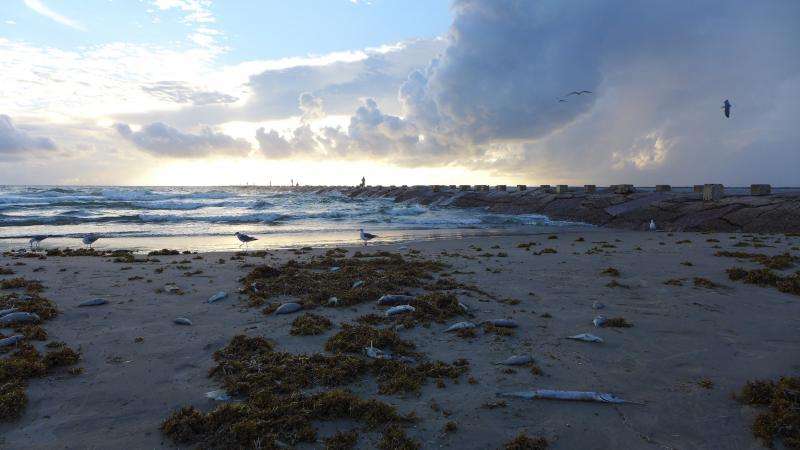Red tide concentrations increasing along South Padre Island

Evidence of red tide along South Padre Island and the Lower Laguna Madre continues to mount, but airborne effects are not as bad as previously feared, according to a Texas A&M AgriLife Extension Service marine expert.
"It's a constantly changing situation, but at this point, we are seeing higher cell counts of the organism, a toxic algae, that leads to red tide," said Tony Reisinger, an AgriLife Extension agent for coastal and marine resources with Texas Sea Grant in Cameron County.
Red tides occur naturally and are caused by high concentrations or blooms of microscopic algae called Karenia brevis, Reisinger said. The algae produce a toxin that can affect the central nervous systems of fish, birds, mammals and other animals. In high enough concentrations, it can cause water discoloration, making it appear red, green or brown.
"It's not life-threatening for humans, but it can cause burning eyes, coughing, sneezing, skin irritation and respiratory problems," he said. "Symptoms are temporary, but whenever a red tide alert is issued, it's best for people with respiratory problems, especially asthmatics, and pets to just stay away. Even at low cell counts, red tide can become a problem in onshore winds or rough surf."
Aerosol levels have only reached low to moderate levels, and an alert has not been issued for South Padre Island, Reisinger said. While tourism has fallen off at the resort, anglers continue to fish in the area.
"We've only seen hints of water discoloration offshore on the horizon in the morning," he said. "As a precaution, the Texas General Land Office cancelled its annual Adopt-A-Beach cleanup. We have seen some fish kills along the shore, but not in high numbers like those reported in the Corpus Christi area where this red tide began in mid-October."
Reisinger said currents and winds have pushed the red tide south into the South Padre Island area.
"It's not as bad as predicted," he said. "It seems to be staying to our north, but a norther blew in Friday so it remains to be seen how bad it's going to get."
Red Tide Rangers, a volunteer organization assembled and trained by AgriLife Extension and the University of Texas Rio Grande Valley Coastal Studies Laboratory in South Padre Island, have been testing water samples throughout the area for several weeks to determine red tide cell counts, Reisinger said.
"We're sharing information gathered by the Red Tide Rangers with the various other state and federal agencies involved in this effort, including the National Weather Service, Texas Parks and Wildlife, the Coastal Studies Laboratory and the National Oceanic and Atmospheric Administration."
Reisinger said the Red Tide Rangers, under the direction of Brigette Goza at the Coastal Studies Laboratory, have also become marine mammal caretakers.
"They transported a bottlenose dolphin in distress, likely from red tide, to the lab where Ms. Goza and her staff nursed it back to health. It takes a lot of work, dedication and knowledge to do this correctly. Coordinating with the Texas Marine Stranding Network, they were able to transport the dolphin to Galveston where it will be held for further observation."
Reisinger said the death of a pygmy sperm whale found stranded at the Padre Island National Seashore near Corpus Christi is being investigated.
"The good news is that fishing is still good in our bay," he said. "People are fishing and catching fish in the Lower Laguna Madre, and their catch is safe to eat."
The red tide toxin accumulates in shellfish, but Reisinger said it's too early to tell if it will affect the oyster season scheduled to start later this year.
"People just need to keep abreast of the news on red tide," he said. "Those who want to fish or enjoy the beach should use particulate masks that cover the mouth and nose to help avoid the aerosol. Water droplets collect on the outside of the mask and significantly reduce the impact."
More information: Red tide levels can be monitored online at tpwd.texas.gov/
Provided by Texas A&M University


















